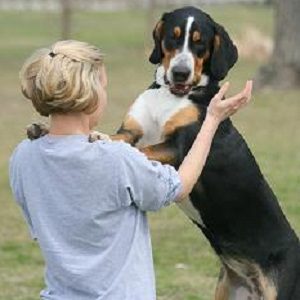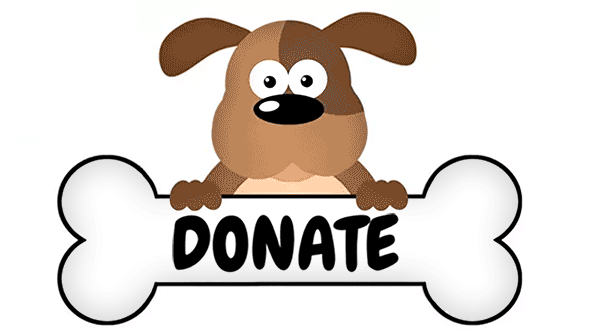 Jumping – helping your dog learn not to jump on you or your guests
Jumping – helping your dog learn not to jump on you or your guests
Jumping on people is normal dog behavior. Dogs jump when excited or anxious, but mostly they jump for attention. When you yell “NO” or push your dog away, you are reinforcing that behavior by giving your dog exactly what he wants.
How do you teach your dog not to jump?
- Prevent your dog from practicing the unwanted behavior.
- Teach your dog an incompatible behavior, like all four paws on the ground.
Sometimes, this means that you manage your dog’s environment by using a crate, baby gate, or another room to separate your dog from your guests. Sometimes, it means tossing treats on the floor or clicking and treating for four paws on the floor. It always means deciding what behavior you want instead and rewarding it.
In the instructions below, we will refer to clicking and treating. A clicker is the most efficient way to train, but you can use a word, like “YES”, in place of the click. A treat will always follow either a click or a yes to mark a behavior you want. Ideally, your treats are small (pea-sized) and really delicious (like chicken or cheese). Some store-bought treats are fine, but go to an independent pet store, where you can find healthier treats. Try to keep treats with you, in various rooms, outside the door you use to come in, and a clicker on you while training.
If you hold your treat up in the air or pull your arm back, you are encouraging your dog to jump. We want to set your dog up for success, not tempt him to give us an unwanted behavior. Always treat your dog on the floor or, if you’re squeamish about the pavement outside, at muzzle level. You want to help him realize that both food and attention come from below.
Dogs are smart. They will learn very quickly that if they jump and then come back down, they will get a treat. They will be convinced that it pays to jump over and over. That’s one reason that you want to catch your dog before he is likely to jump. You probably already know when those times are, but you can also watch for his body to tense before he launches. If you miss that opportunity, ask your dog for another skill to break up his jumping habit.
Time to Start Training
Let’s assume that your dog jumps for attention. You’ll need a helper to act as the “stranger.” With your dog on a leash, and a clicker and treats on you, ask your helper to stand still on the sidewalk. When your dog sees the helper, click and treat in quick succession because your dog did the right thing – four paws on the ground. At the same time, you are preventing him from practicing the behavior you don’t want – jumping.
Ask your helper to take a step toward you. Once again, click and treat multiple times to prevent jumping. If your dog starts to jump, have your helper turn around and go back to her original position. Click and treat your dog in quick succession when he has all four paws on the ground. If he is doing well, your helper can get close enough to calmly and briefly touch your dog. If your dog jumps, she should back away. Eventually, your dog will understand that four paws on the ground brings the person closer. Keep greetings short and calm, so your dog can be successful when starting this training.
Your dog will learn quickly that four paws on the floor, not jumping, gives him everything he wants. He will be rewarded with treats AND be able to interact. Once this behavior is reliable, you can make your click and treat more random and then infrequent. Don’t move too fast, though.
You can take this exercise one step further by practicing at the door. Doorways are particularly exciting places for dogs; after all, you sound excited when guests come in. Put your dog on a leash. The leash is to keep your dog from running out the door, NOT to pull him back if he jumps. Have your helper ring the doorbell or knock on the door. Throw treats on the ground to prevent jumping and ask your helper to ignore your dog. If your dog keeps his paws on the ground, click and treat multiple times. If your dog jumps, have your helper turn around and leave, closing the door behind her.
Try again. When your dog finally keeps his paws on the floor, have your helper take a few slow steps inside. Continue to click and treat as long as your dog keeps his feet down. If he does jump, she should leave.
You, and not your helper, should be the one with treats, so that your dog focuses on you, instead of your “guest”. If you are someone who enjoys training, teach your dog a behavior that you would prefer for greeting – not just standing, instead of jumping. For example, it can be “sit”, “go say hi”, holding a toy, or going to a “greeting station”. You probably need a positive trainer, though, to get you started on how to teach most of these behaviors.
Politely Greeting Guests
If your dog tends to jump on people when they come into your house, you should first consider using a gate, crate, or another room, so your dog can’t jump on your visitor. Put a treat at your dog’s nose and then scatter treats over the gate. Or give your dog a long-lasting chewie, like a Kong or bully stick, and white noise or music if you put your dog in another room. Repairmen especially often go in and out and can’t be held responsible if your dog slips out. (Most fearful dogs even prefer alone time with a special toy away from the commotion and “scary” person.)
If, however, the visitor is a neighbor or friend who comes over often, scatter treats on the floor, so your dog has something to do and isn’t tempted to jump. Click and treat the whole time your dog has his feet on the ground, while asking your guest to ignore your dog until he is calmer. Putting a note on the front door can be helpful. Remember that you need to practice with your helper before your dog gets overly excited to see a guest.
The “I’m SOOOO Glad You’re Home!” Jump
Many dogs jump on their humans when they walk through the door coming home. Imagine wearing stockings and a good dress or suit! Try this if your dog just can’t contain his enthusiasm at seeing you. When you come home, throw treats on the ground, so your dog doesn’t practice jumping, and keep walking, instead of lavishing attention on your dog. A few minutes later, after everything has settled down (and you have changed clothes), you can give him plenty of attention – just not the minute you walk in the door. Stay at his level and calm. If your dog tries jumping on you, wait until all four paws are down. Then, click and treat multiple times to prevent him from jumping again.
What About Other Situations at Home?
There are other situations at home that encourage jumping – like when you let your dog out of a crate or take down the baby gate. Another time is when your family is playing, especially with children running around. Be ready! If you and your family click and treat consistently before your dog is likely to jump, your dog will start preferring to stay down. If he does jump, ignore him. No treats and no attention.
Here’s another nifty exercise you can do at home. Run around the room – an exciting, jump-worthy game for most dogs. Then, stop and click-treat before your dog launches at you. Increase the level of excitement over time. If you have children, this exercise can be particularly helpful, but the adults in the house should be the ones doing it. This will help not only with jumping, but also with your dog’s impulse control. A twofer!
The key is consistency. Everyone in your home needs to be on the same page. Instead of yelling “no”, pushing your dog away, or even kneeing him (yes, some people still do that), it’s important to teach your dog an alternative behavior, like feet on the ground. Your dog won’t know what you want him to do, instead of jumping, if you haven’t taught him.
Key Points to Remember
- Jumping is usually an attention-seeking behavior. You want to teach your dog an alternative behavior – like standing, instead of jumping.
- Scattering treats on the ground and clicking/treating for feet on the floor will prevent your dog from jumping, while also teaching him that good things come from below.
- Set your dog up for success by practicing these exercises with a friend BEFORE you meet people on the street or in your home.
- When your dog jumps at you at the dog park (which we don’t recommend), recognize that as a sign that your dog wants to leave.
- Give your dog attention and treats at random times when he is calm, not only when you are working on his jumping behavior.
Resources
In the Books section of our website at https://yourdogsfriend.org/we-recommend/books-treats-products/, there are books in the Training and Behavior sections that cover jumping.
Your Dog’s Friend has a webinar video on greeting behavior at https://www.youtube.com/watch?v=GL8FyvTCk_U
Your Dog’s Friend is a 501-c3 non-profit organization that educates and supports dog parents. We offer behavior and training advice; sponsor FREE workshops on a variety of topics; run positive dog training, behavior-related, and sports classes; refer dog parents to trainers, dog walkers, and other professionals; and send an e-newsletter with articles, resources, and announcements.
This material is not intended to be a substitute for professional help when dealing with dogs with intense or potentially dangerous behavior issues. Consider consulting a positive reinforcement trainer or animal behaviorist for situations that you feel are dangerous or that you don’t feel equipped to handle. A list of recommended trainers and behaviorists can be found on our website, www.YourDogsFriend.org.




